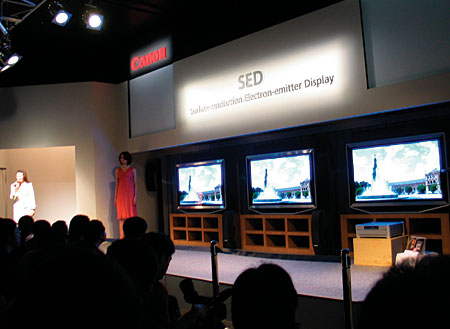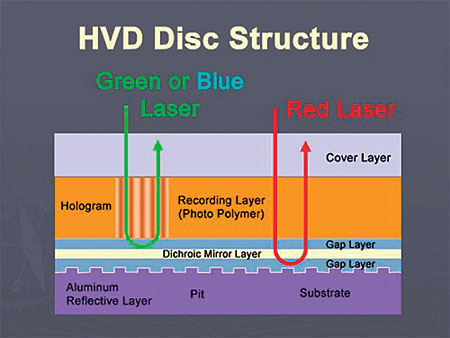Future Tech
In a grand-scale, universal sort of way, January 1st means nothing. We ugly bags of mostly water view the start of each year as a new beginning. To some, it's in a Neil Finn "I'm not the old girl, I'm someone new" kind of way. To others, it's the first day of many where we promise we'll start that diet tomorrow. To most people, it's a day to nurse hangovers and the start of a month-long repetition of curses as we keep writing 2006 on checks. Let's concentrate on somewhere between the extremes and look at new technology that's coming...someday.

Spotted at CEATEC: the world's first 55-inch SED panels. More should be here soon.
Quantum Dots
A quantum dot is a tiny semiconductor that glows when you give it energy. Such dots glow at different wavelengths, depending on their size. And, when I say "size," keep in mind that about 3 million of these things could fit across your thumb. Thus, there is a potential for even thinner, lighter, and more power-efficient displays. The drawback? Until recently, the dots cost upward of $2,000 per gram. So, they're a bit pricey. That cost has come down of late, and, with advancements in their cousin technology, OLED, these dots could get popular. The largest display at the moment is monochromatic and has a resolution of 32 by 64. This is a little small for watching DVDs, but they'll get bigger.
Blu-ray and HD DVD Are for Chumps
Several companies, including Hitachi/Maxell and Optware, are working on holographic media. In the latter's case, projected disc space—on something the size of a DVD—will be in the multiple-terabyte range (100 times more than HD DVD or Blu-ray). Optware's HVD format works by sending two lasers, one red and one green or blue, toward the disc. A layer reflects the green or blue laser and lets the red laser pass through. The red laser reads a layer of pits and lands (like with a regular DVD). The green or blue laser reads the data-containing layer in three dimensions (back and forth, as with a DVD, and also vertically). That's thousands of hours of 1080p/24 content on one disc. Don't expect it in a home format any time soon.
Mega Contrast LCD
Shown at the past several trade shows, Sharp's Mega Contrast LCD looks exactly as the name suggests. Their claimed contrast ratio of 1,000,000:1 seems a bit far-fetched, but it does offer a noticeable improvement over other LCDs and plasmas (until you read the next item below, at least). Sharp remains fairly tight-lipped on how the technology works exactly, but they will say that it has a "new panel structure, newly developed materials different from conventional LCDs, and minimized distinctive factors that deteriorate contrast ratio, such as minute birefringence, scattering, and reflection of lights, thus exceeding the contrast ratio of CRT." Uh huh. Hey, it looks cool, and we want one. So far, it's not a consumer product (or even a U.S. product at all). Maybe someday.
20,000:1 Contrast-Ratio Plasma
At CEATEC this year, Pioneer showed off a next-generation panel that we should see here in a year or so. They claim a rather outrageous 20,000:1 contrast ratio—outrageous, that is, until you see it in action. It has a legitimate black level, made that much more impressive as it comes from a company that isn't typically known for good black levels. It looks as good as SED.

Yeah, Where Is SED?
Also at this past CEATEC, Toshiba/Canon showed off three 55-inch SED panels. This would be perfect if only three people wanted them. I'm guessing that more will be getting in that line. They are going to make the first round of panels in a Canon facility, but they should be breaking ground soon on a whole new manufacturing plant. They're now saying the sets will be available by the end of this year, but with limited availability. They've said "the end of next year" for each of the past three years, so we shall see. I've heard another rumor (third-hand, so take it for what it is) of an initial price of $10,000. I'm sure they could sell all three that they have at that price. I'm not sure how many more, though. If that is the price (and I have no idea if it is), then, to be sure, it will drop quickly as the new plant ramps up production.
And OLED?
OLEDs are everywhere—that is, everywhere but home theater. Phones, MP3 players, car stereos, and so on are all using OLEDs instead of power-hungry LCDs. The issues putting OLEDs into the home are similar to what they were a few years ago: getting the blue to last longer and making sure they're watertight. Companies like Sony, Mitsubishi (not the TV division), and Samsung have all talked about OLED to varying degrees. It's a fascinating technology with great potential, but it's a long way off.
Anyone Have 1.21Jigawatts?
So, for the moment, we're stuck with plasma, LCD, DLP, LCOS, and, if you're into the retro scene, CRT. Who knows where or how good (and cheap) these technologies will be when those discussed in this article finally hit the market.













































